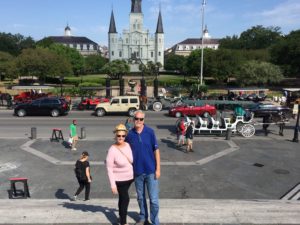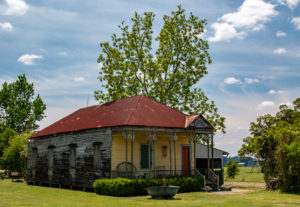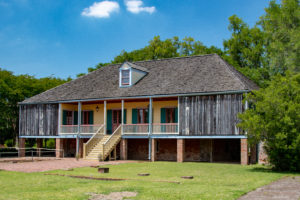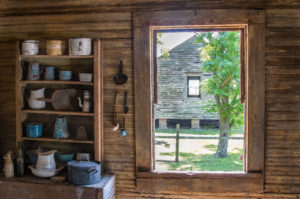
After a great time in Texas, it is time to move on from Austin and head into Louisiana. We head east on I10 and spend a boondocking (free) evening in Winnie, TX. A nice county park, lots of open space, in fact we are the only people there. A few people had horses there for an evening workout but what a change for us – no neighbors, no freeway noise, just us! the park area is quite large and is the location of their annual Rice Festival – I’m sure it is a big deal there!

In the morning we continue east on I10, a particularly rough section of freeway, until Louisiana. We are told that LA was the last state to adopt the 21 year old minimum drinking age, and that was tied to federal highway funding, so highway repairs are more recent than Texas. Anyway, the freeway over the water was quite scenic, smooth and easy to drive!
We exited at the Atchafalaya (Swamp) visitor center, with the intention of overnighting there. After resting up a bit and getting our share of brochures and maps, Laura finds a great campground, just down the road a bit. Frenchmans Wilderness campground, in Breaux Bridge was incredibly beautiful. Located right on a swamp, there was plenty of space for Grayce to run and walk, and for Jeff to walk, too. No running these days 😉


On a walk with Grayce we saw an alligator dive into the water. Of course her Labrador instincts kicked in and she bolted towards the movement, but I have learned to “always” keep her on her leash, (remembering the skunk encounter). Fortunately, the alligator was far enough away, probably 20 ft, and her leash was short, probably 10 ft. No real danger, but still pretty exciting.
The swamp areas are stunningly beautiful and spooky at the same time.



One evening we traveled between the Atchafalaya River and the swamp, for dinner where the locals eat. Pats restaurant is right on the water, where Laura sees a water moccasin (from a safe distance) and a wait staff said that is common, in fact they often get alligators visiting the restaurant. On the “interesting” side, on our way back to the RV, after a beautiful sunset, the bugs were everywhere. So many, in fact, that driving through them sounded like driving into a rainstorm! Fortunately we only had 10 miles or so to go and the road was still somewhat visible through the thickly covered windshield!


We learned how to “prepare” and eat crawfish, had fried oysters, crabs, Etouffee and other southern Louisiana dishes. All from the swamp and local river. The French-Cajun-Creole culture is so rich (and their accent, too!), there that we definitely will be back!
Next we head over to New Orleans. The RV park is on a canal from Lake Ponchartrain, although we could not get right on the water, it was still a good location. An on site restaurant, (complete with crawfish boil), and plenty of room for Grayce to chase her frisbee, plus it was only about 15 minutes from the French Quarter. The FQ was very busy with tourists. More than just the tourists made it feel much like Disneyland. All of the tourist swag that you could ever “need” is there. Stops in Jackson Square for the requisite photo documentation, then to Duvals for beignets, to Central Market for muffuletas, (see a food trend here?)…

We took the hop-on-hop-off bus around Nolo and found the guides commentary generally informative, (some attempts at humor were, well, what you would expect). There is so much history there and the importance of this city to the early growth of the US was lost on me, (maybe snoozing in history class?). The early 1800’s must have been an incredible time! So much (brick) building after a couple of fires destroyed much of the wooden buildings.


The Mississippi River, of course, is the reason that the city exists at all, but all up and down the river the importance of trade on the river is still very evident.

There is still evidence of hurricane Katrina today, although these are in depressed areas that probably should be cleared and rebuilt anyway. Speaking of this, the central part of the French Quarter appears to be quite healthy because of the tourists, but surrounding areas don’t look like the Disney-esque Nolo that most tourists will remember. My impression of the reason for this is the “not my job” syndrome. Numerous comments by locals support that: A waitress blamed the flooding from Katrina on “men – if they had just done their job” there would have been no flooding. I didn’t pursue this any further.
We also took a walking tour through the Garden District. Great homes, many with varying examples ornate architecture, largely copied from Paris. Lots of wrought iron fences and balconies. The pink colored home below is where Mark Twain stayed for a while. Across the street is a house that Jefferson Davis (president of the Confederacy) lived and died. So much history here, this city is a place to revisit some day.



A short stroll through one of the above ground cemeteries was “necessary”. The commonly held, and incorrect, belief is that the grave site was located above ground due to the high water level, however, the reality is that these are family burial plots, with a pit directly under the above ground structure. The most recent internment is in the raised portion with the previously deceased tenant “delicately” pushed off a ledge into the excavated area below, called the caveau (cave). A long pole was used and the saying “I wouldn’t touch that with a 10 foot pole” came into use.


A trip to Louisiana would not be complete without a visit to Avery Island where Tabasco is made. The self guided plant tour was informative but the adjacent Jungle Gardens was incredible! It is a botanical garden that is driveable. Back in the day, when the McIlhenny family was actively making the famous hot sauce, this must have been world class. Now it is showing its age but the variety of plants and eco-zones is impressive. One area that is fascinating is a protected area for nesting Snowy Egrets. A raised structure above a lake with alligators provides safe nesting – the alligators keep predators away from the hatchlings. A raised viewing area for us humans gave a great view of the hundreds (thousands?) of birds. Oh, and can you say noisy? Wow!




Along the Mississippi River were hundreds of sugar cane farms in the mid 1800’s, each one, a slice of land that butts up to the river. Today there are still some very impressive remaining plantation houses, though, fortunately the practices associated with them are gone.

We toured the Laura Plantation, (no small mystery as to why Laura picked that one). It turned out to be incredibly fascinating, humbling, sad and left us with strong emotions weeks later. The daily life on this plantation was brutal. On the tour grounds are the main house, pretty grand, some outbuildings, like the kitchen and some slaves houses. The houses were moved close to the main house for the tourists. The actual location of the slaves homes was 3 miles off. Imagine having to walk that distance each day, through that oppressive heat and humidity. Brutal.










All in all, Louisiana was a very memorable place with so, so much more to explore, visit and eat. Gonna come back with my camera and an appetite! Next stop, Mississippi.
